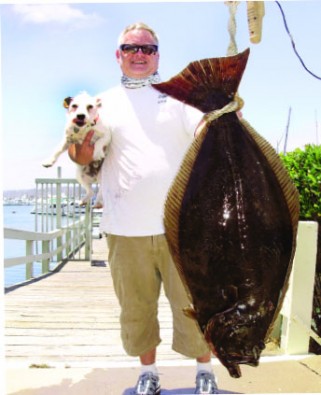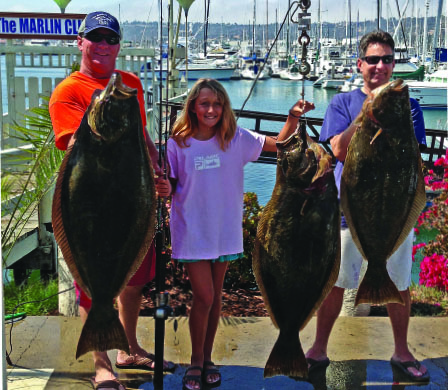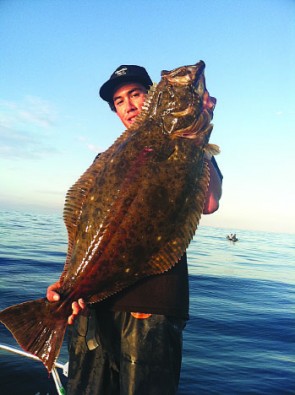 With the approach of summer, California halibut are slowly moving into the medium water depths to fatten up before working into the shallows to spawn. This fishery has made a huge comeback and now 40 pounders are fairly commonplace throughout the state—so maybe you’ll get to check that one off your bucket list.
With the approach of summer, California halibut are slowly moving into the medium water depths to fatten up before working into the shallows to spawn. This fishery has made a huge comeback and now 40 pounders are fairly commonplace throughout the state—so maybe you’ll get to check that one off your bucket list.
Many of today’s fishermen never experienced good halibut action when they were younger, so they pretty much have written off the game as something not worth their effort or attention. But today, with the gill net regulation modifications keeping the commercial nets outside three miles off the coast, halibut fishing seems to continue improving every year.
Those regulations, incidentally, were passed in the early 1990s and went into enforcement in 1994 as the Marine Resources Protection Act, which is still in place today. This proves that some regulations really work. And those that may not appear beneficial immediately begin to bear fruit with time. The improvements in the halibut fishery we are seeing were decades in the making so understand that recoveries take time, decades in some cases.
“The fishery has certainly made a comeback,” California Fish and Wildlife marine biologist Travis Tanaka confirms to PCS. “There has been an abundance of squid on the coast and more so in the last six years than ever, so as always with good feed fish are bigger and there are more breeders.”
He explained the current bag limit for recreational anglers north of Big Sur is three halibut per day but that it has been expanded to five halibut per day south of Big Sur. Another fact Tanaka shared was that the males do actually get bigger than most people think.
“We have tagged males that were as large as 25 pounds; although that is an exceptionally large male, they do get big,” he says.
These big males have played a large part in the comeback of the species as they are able to fertilize many more eggs than the younger males. With gill nets gone, larger brood stock are available to help sustain the fish populations.
Study of the species turned up that one tagged 22-inch California halibut moved from Manhattan Beach all the way to Morro Bay. The main stock is concentrated from Bodega Bay south, according to Tanaka, though some may be found all the way north to Washington. More data can be found by going to the DFG website (www.dfg.ca.gov), clicking on the “Marine” tab and then looking under “Marine Regional Projects” for the studies of interest to you.
Getting Located
From an angling perspective, as spring moves into summer we typically find the fish slowly moving into shallower water and therefore grouping up a bit more. This gives us a much better shot of connecting on this sometimes illusive quarry. The females will feed heavily on baitfish waiting for just the right conditions to spawn. Specifically, these are conditions where the water is above 66 degrees (at least in San Diego, but likely cooler to the north) and a somewhat off color water with low visibility to keep predators from their eggs.
They will come right into the shoals in as little as 10-foot depths to lay their eggs. When in this pre-spawn stage there are a couple things to look for. Keep an eye on the meter, especially if you are fishing an exclusively sandy area. The bait balls travel and the halibut travel with them. If you can find an area that is holding multiple bait balls spend some time and make several different drifts crisscrossing the zone as much as possible. When you get a bite hit the MOB (Man Overboard) or mark the waypoint on the GPS.
Keep in mind halibut do group up. There will likely be many smaller male fish around the bigger females so if you catch one chances are he was not alone. I like to think when I catch a small one there is likely a big one somewhere in the close vicinity and so I will spend a lot of time right there, trying to find her—and believe me I have.
 As noted, for the last few years we have been blessed with a huge influx of squid to the California coast and a boon to the recent comeback in the halibut population, adding to the forage base of various fin bait. This has really produced a bigger volume of these larger model halibut which grow into the breeders that produce huge amounts of eggs. The widespread availability of the cephalopods gives us many different areas to target. The market squid that bed up on our California coast can land just about anywhere, typically bedding up in 60 to 120 feet along the coast.
As noted, for the last few years we have been blessed with a huge influx of squid to the California coast and a boon to the recent comeback in the halibut population, adding to the forage base of various fin bait. This has really produced a bigger volume of these larger model halibut which grow into the breeders that produce huge amounts of eggs. The widespread availability of the cephalopods gives us many different areas to target. The market squid that bed up on our California coast can land just about anywhere, typically bedding up in 60 to 120 feet along the coast.
Not all squid beds will be holding fish, however. The likelihood of halibut being present on these beds seems to be toward the middle to end of the spawn out on these squid beds. I have seen it time and time again where the fish just have not located the new beds. There is an abundance of squid present but no fish … yet!
You may have to try several beds before locating the flatties—the only downside to having so much squid in our waters.
Rigs and Rods
Many halibut fishermen have employed the sliding sinker set-up and still go to it. But I choose the triple swivel rig while drifting. On long soaks while drifting the bottom, a slider will collect eel grass and send it straight up to the hook and bait. The three-way swivel does not allow this to happen as the weight sheds the grass instead of collecting it.
Another benefit of the three way swivel rig is that it keeps the bait elevated, which is imperative for halibut in the general vicinity to be able to spot it. The slider tends to drag baits to close to the bottom, yet these fish are looking up and have very limited visual range across the bottom.
Some anglers prefer to let the fish run with the bait and the slider allows this, and I can’t argue that. However, you are also putting excessive slack in the line while they run, often making for a weak hook-set. Halibut are ambushers so there is no need to let them run with the bait. Many times it is already in their gullet and should they feel resistance, they are very good at regurgitating bait and sending you back a bait that has big rakes across it.
Although many people think this is evidence of a “short bite,” my feelings are that many of these baits actually did reach their mark but were simply spit out when the fish realized there was something wrong. I always go for quick hook-sets on halibut.
 This brings up another long-debated subject among halibut fishermen: the trap hook. Many add a treble hook to the tail end of the baitfish, be it a mackerel, sardine or anchovy. This in an attempt to get those aforementioned short biters. But let’s play out a halibut bite in words: Your bait comes across the top of a halibut sitting along the sandy bottom. When the fish strikes it is with a powerful aggressive maneuver and will normally go straight back to the bottom.
This brings up another long-debated subject among halibut fishermen: the trap hook. Many add a treble hook to the tail end of the baitfish, be it a mackerel, sardine or anchovy. This in an attempt to get those aforementioned short biters. But let’s play out a halibut bite in words: Your bait comes across the top of a halibut sitting along the sandy bottom. When the fish strikes it is with a powerful aggressive maneuver and will normally go straight back to the bottom.
In water with decent visibility, I believe that a natural presentation will out-fish an unnatural presentation at a ratio of 3:1. That would mean I am afforded three times the chances and likely more big fish bites. By adding a treble hook to the back of your bait you not only create an unnatural presentation, but one that is spinning and one more likely to kill the bait prematurely. A secondary issue with the trap rig is it does not conform to IGFA angling rules, meaning it is not a legal rig for most fishing club anglers.
With suitable equipment there is a huge array of rods and reels for halibut and they all have specific purposes, but for the most part an eight-foot rod rated anywhere from 12- to 25-pound test is a good call. When bay fishing, I prefer to use a medium eight-foot trigger stick with a short 12- or 15- pound fluorocarbon leader straight to spectra backing. Matching that would be a small lever drag or larger levelwind reel. While fishing the outside I will go up to a light eight-foot jig stick with a smaller lever drag reel such as the Andros 5 II speed. In the deeper water I would go to a lighter action graphite eight-foot jig stick and maybe step-up the reel one size. Regardless, the graphite is a key for all halibut rigs as you want to be able to set that hook cleanly.



